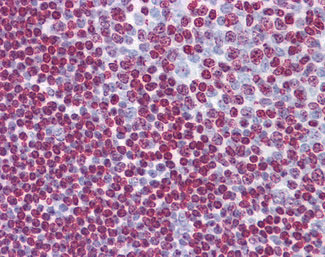ATR Antibody (clone 1E9)
Mouse Monoclonal Antibody
- SPECIFICATION
- CITATIONS
- PROTOCOLS
- BACKGROUND

Application
| IHC-P, E |
|---|---|
| Primary Accession | Q13535 |
| Reactivity | Human |
| Host | Mouse |
| Clonality | Monoclonal |
| Clone Names | 1E9 |
| Calculated MW | 301kDa |
| Dilution | IHC-P (5 µg/ml) |
| Gene ID | 545 |
|---|---|
| Other Names | Serine/threonine-protein kinase ATR, 2.7.11.1, Ataxia telangiectasia and Rad3-related protein, FRAP-related protein 1, ATR, FRP1 |
| Reconstitution & Storage | Store at -20°C. Aliquot to avoid freeze/thaw cycles. |
| Precautions | ATR Antibody (clone 1E9) is for research use only and not for use in diagnostic or therapeutic procedures. |
| Name | ATR {ECO:0000303|PubMed:14729973, ECO:0000312|HGNC:HGNC:882} |
|---|---|
| Function | Serine/threonine protein kinase which activates checkpoint signaling upon genotoxic stresses such as ionizing radiation (IR), ultraviolet light (UV), or DNA replication stalling, thereby acting as a DNA damage sensor (PubMed:10597277, PubMed:10608806, PubMed:10859164, PubMed:11721054, PubMed:12791985, PubMed:12814551, PubMed:14657349, PubMed:14729973, PubMed:14742437, PubMed:15210935, PubMed:15496423, PubMed:16260606, PubMed:21144835, PubMed:27723717, PubMed:27723720, PubMed:33848395, PubMed:9427750, PubMed:9636169, PubMed:21777809, PubMed:25083873, PubMed:30139873, PubMed:37788673, PubMed:37832547). Recognizes the substrate consensus sequence [ST]-Q (PubMed:10597277, PubMed:10608806, PubMed:10859164, PubMed:11721054, PubMed:12791985, PubMed:12814551, PubMed:14657349, PubMed:14729973, PubMed:14742437, PubMed:15210935, PubMed:15496423, PubMed:16260606, PubMed:21144835, PubMed:27723717, PubMed:27723720, PubMed:33848395, PubMed:9427750, PubMed:9636169). Phosphorylates BRCA1, CHEK1, MCM2, RAD17, RPA2, SMC1 and p53/TP53, which collectively inhibit DNA replication and mitosis and promote DNA repair, recombination and apoptosis (PubMed:9925639, PubMed:11114888, PubMed:11418864, PubMed:11865061, PubMed:21777809, PubMed:25083873). Phosphorylates 'Ser-139' of histone variant H2AX at sites of DNA damage, thereby regulating DNA damage response mechanism (PubMed:11673449). Required for FANCD2 ubiquitination (PubMed:15314022). Critical for maintenance of fragile site stability and efficient regulation of centrosome duplication (PubMed:12526805). Acts as a regulator of the S-G2 transition by restricting the activity of CDK1 during S-phase to prevent premature entry into G2 (PubMed:30139873). Acts as a regulator of the nuclear envelope integrity in response to DNA damage and stress (PubMed:25083873, PubMed:37788673, PubMed:37832547). Acts as a mechanical stress sensor at the nuclear envelope: relocalizes to the nuclear envelope in response to mechanical stress and mediates a checkpoint via phosphorylation of CHEK1 (PubMed:25083873). Also promotes nuclear envelope rupture in response to DNA damage by mediating phosphorylation of LMNA at 'Ser-282', leading to lamin disassembly (PubMed:37832547). Involved in the inflammatory response to genome instability and double- stranded DNA breaks: acts by localizing to micronuclei arising from genome instability and catalyzing phosphorylation of LMNA at 'Ser-395', priming LMNA for subsequent phosphorylation by CDK1 and micronuclei envelope rupture (PubMed:37788673). The rupture of micronuclear envelope triggers the cGAS-STING pathway thereby activating the type I interferon response and innate immunity (PubMed:37788673). Positively regulates the restart of stalled replication forks following activation by the KHDC3L-OOEP scaffold complex (By similarity). |
| Cellular Location | Nucleus. Chromosome. Nucleus envelope. Note=Depending on the cell type, it can also be found in PML nuclear bodies (PubMed:12814551). Recruited to chromatin during S-phase (PubMed:14871897). Redistributes to discrete nuclear foci upon DNA damage, hypoxia or replication fork stalling (PubMed:27723720). Relocalizes to the nuclear envelope in response to mechanical stress or DNA damage (PubMed:25083873, PubMed:37832547) Also localizes to the micronuclear envelope in response to response to genome instability (PubMed:37788673). |
| Tissue Location | Ubiquitous, with highest expression in testis. |

Thousands of laboratories across the world have published research that depended on the performance of antibodies from Abcepta to advance their research. Check out links to articles that cite our products in major peer-reviewed journals, organized by research category.
info@abcepta.com, and receive a free "I Love Antibodies" mug.
Provided below are standard protocols that you may find useful for product applications.
Background
Serine/threonine protein kinase which activates checkpoint signaling upon genotoxic stresses such as ionizing radiation (IR), ultraviolet light (UV), or DNA replication stalling, thereby acting as a DNA damage sensor. Recognizes the substrate consensus sequence [ST]-Q. Phosphorylates BRCA1, CHEK1, MCM2, RAD17, RPA2, SMC1 and p53/TP53, which collectively inhibit DNA replication and mitosis and promote DNA repair, recombination and apoptosis. Phosphorylates 'Ser-139' of histone variant H2AX/H2AFX at sites of DNA damage, thereby regulating DNA damage response mechanism. Required for FANCD2 ubiquitination. Critical for maintenance of fragile site stability and efficient regulation of centrosome duplication.
References
Bentley N.J.,et al.EMBO J. 15:6641-6651(1996).
Cimprich K.A.,et al.Proc. Natl. Acad. Sci. U.S.A. 93:2850-2855(1996).
Mannino J.L.,et al.Gene 272:35-43(2001).
Totoki Y.,et al.Submitted (MAR-2005) to the EMBL/GenBank/DDBJ databases.
Keegan K.S.,et al.Genes Dev. 10:2423-2437(1996).
If you have used an Abcepta product and would like to share how it has performed, please click on the "Submit Review" button and provide the requested information. Our staff will examine and post your review and contact you if needed.
If you have any additional inquiries please email technical services at tech@abcepta.com.













 Foundational characteristics of cancer include proliferation, angiogenesis, migration, evasion of apoptosis, and cellular immortality. Find key markers for these cellular processes and antibodies to detect them.
Foundational characteristics of cancer include proliferation, angiogenesis, migration, evasion of apoptosis, and cellular immortality. Find key markers for these cellular processes and antibodies to detect them. The SUMOplot™ Analysis Program predicts and scores sumoylation sites in your protein. SUMOylation is a post-translational modification involved in various cellular processes, such as nuclear-cytosolic transport, transcriptional regulation, apoptosis, protein stability, response to stress, and progression through the cell cycle.
The SUMOplot™ Analysis Program predicts and scores sumoylation sites in your protein. SUMOylation is a post-translational modification involved in various cellular processes, such as nuclear-cytosolic transport, transcriptional regulation, apoptosis, protein stability, response to stress, and progression through the cell cycle. The Autophagy Receptor Motif Plotter predicts and scores autophagy receptor binding sites in your protein. Identifying proteins connected to this pathway is critical to understanding the role of autophagy in physiological as well as pathological processes such as development, differentiation, neurodegenerative diseases, stress, infection, and cancer.
The Autophagy Receptor Motif Plotter predicts and scores autophagy receptor binding sites in your protein. Identifying proteins connected to this pathway is critical to understanding the role of autophagy in physiological as well as pathological processes such as development, differentiation, neurodegenerative diseases, stress, infection, and cancer.


